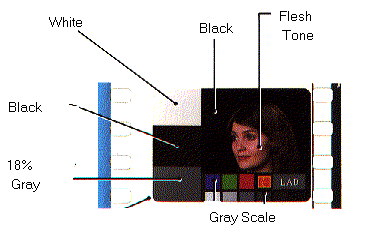
China Girl (film term)
Encyclopedia

Porcelain
Porcelain is a ceramic material made by heating raw materials, generally including clay in the form of kaolin, in a kiln to temperatures between and...
) mannequins, or the make-up worn by the live models made them appear to be mannequins.
Originally the "China Girl" frames were created in-house by laboratories to varying standards, but in the mid-1970s engineers from the Eastman Kodak Company developed the Laboratory Aim Density system as a means of simplifying the production of motion picture prints. Under the LAD system, Kodak created many duplicate negatives of a single China Girl and provided them to laboratories to include in their standard leaders. These LAD frames were exposed to specific guidelines and allowed a laboratory technician to quickly make a subjective evaluation of a print's exposure and colour tone by looking at the China Girl herself. If a more objective evaluation was required, a densitometer can be used to compare the density of the colour patches in the LAD frame with Kodak's published guidelines.
In keeping with changes to the modern laboratory process, Kodak also provide a "Digital LAD" to be incorporated in the film-out
Film-out
Film-out is the process in the computer graphics, video production and filmmaking disciplines of transferring images or animation from videotape or digital files to a traditional film print...
process to check the accuracy of the film printer and processor.
Recently "China Girl" images have been the subject of an art exhibit by Julie Buck
Julie Buck
Julie Anne Buck is an American collage artist, photographer, filmmaker, and film archivist who lives in New York City.-Life:...
and Karin Segal.

